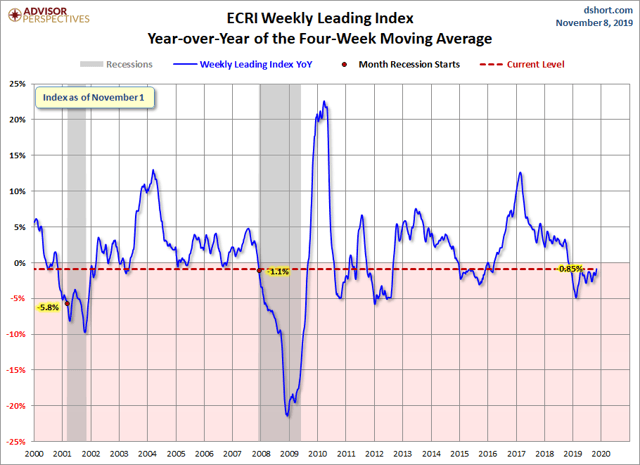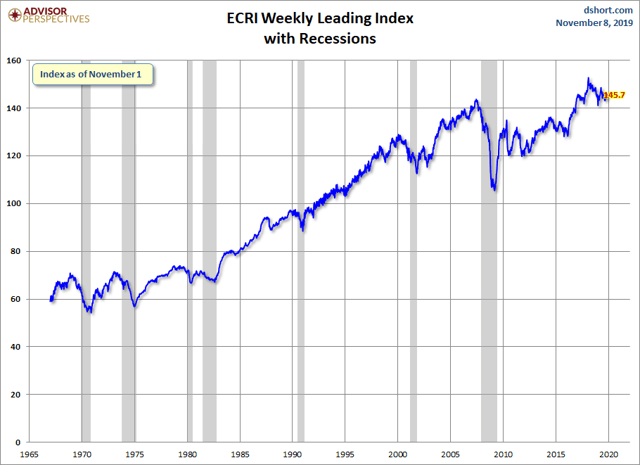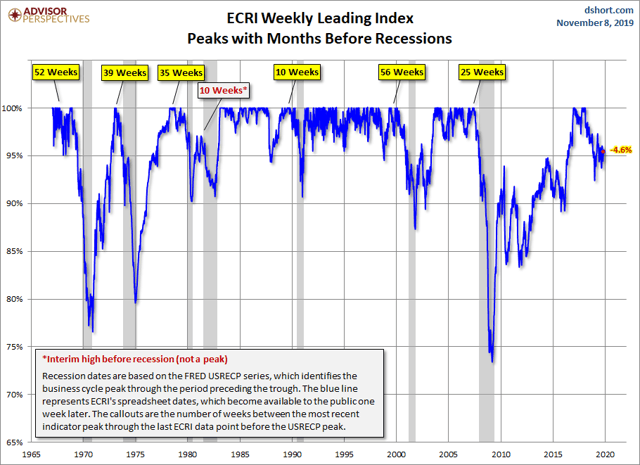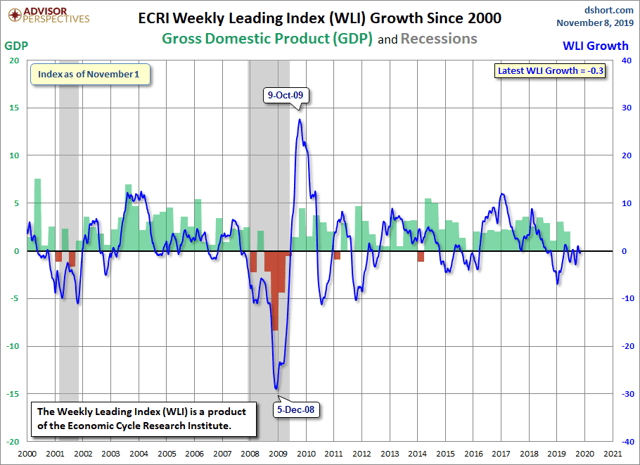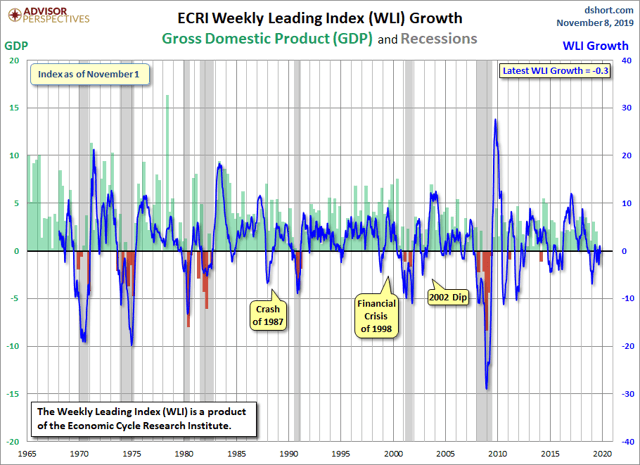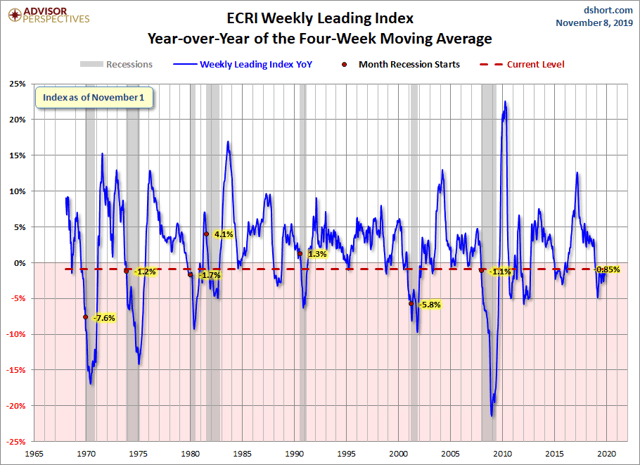ECRI Weekly Leading Index Update
ECRI Weekly Leading Index Update
Summary
摘要
By Jill Mislinski
吉爾·米斯林斯基(Jill Mislinski)著
This Nov. 8 morning's release of the publicly available data from ECRI puts its Weekly Leading Index (WLI) at 145.7, up 0.5 from the previous week. Year-over-year, the four-week moving average of the indicator is now at -0.85%, up from last week. The WLI Growth indicator is now at -0.31, up from the previous week.
11月8日上午,ECRI公佈的公開數據顯示,其每週領先指數(WLI)為145.7,比前一週上升了0.5%。與上年同期相比,該指標的四周移動均值目前位於-0.85%,高於上週的水平。WLI增長指標目前為-0.31,高於前一週。
The ECRI Indicator Year-over-Year
ECRI指標同比
Below is a chart of ECRI's smoothed year-over-year percent change since 2000 of their weekly leading index. The latest level is above where it was at the start of the last recession.
以下是ECRI自2000年以來每週領先指數平穩的同比百分比變化圖表。最新水平高於上次衰退開始時的水平。
Appendix: A Closer Look at the ECRI Index
附錄:詳細瞭解ECRI指數
The first chart below shows the history of the Weekly Leading Index and highlights its current level.
下面的第一張圖表顯示了周度領先指數的歷史,並突出顯示了其當前水平。
For a better understanding of the relationship of the WLI level to recessions, the next chart shows the data series in terms of the percent-off the previous peak. In other words, new weekly highs register at 100%, with subsequent declines plotted accordingly.
為了更好地理解WLI水平與衰退的關係,下一張圖表顯示了從前一個峯值下降的百分比的數據系列。換言之,周線新高為100%,隨後的下跌趨勢也相應出現。
As the chart above illustrates, only once has a recession ended without the index level achieving a new high - the two recessions, commonly referred to as a "double-dip," in the early 1980s. We've exceeded the previously longest stretch between highs, which was from February 1973 to April 1978. But the index level rose steadily from the trough at the end of the 1973-1975 recession to reach its new high in 1978. The pattern in ECRI's indicator is quite different, and this has no doubt been a key factor in their business cycle analysis.
正如上圖所示,只有一次衰退結束後,指數水平沒有達到新高--20世紀80年代初的兩次衰退,也就是通常所説的“二次探底”。我們已經超過了之前高點之間最長的一段時間,也就是1973年2月到1978年4月。但該指數水平從1973-1975年經濟衰退結束時的低谷穩步上升,並在1978年達到新高。ECRI指標的模式非常不同,這無疑是他們進行商業週期分析的關鍵因素。
The WLIg Metric
WLIg指標
The best known of ECRI's indexes is their growth calculation on the WLI. For a close look at this index in recent months, here's a snapshot of the data since 2000.
ECRI最著名的指數是它們對WLI的增長計算。要仔細觀察近幾個月的這一指數,以下是自2000年以來的數據快照。
Now let's step back and examine the complete series available to the public, which dates from 1967. ECRI's WLIg metric has had a respectable record for forecasting recessions and rebounds therefrom. The next chart shows the correlation between the WLI, GDP, and recessions.
現在,讓我們退後一步,看看公眾可以看到的完整系列,這些系列可以追溯到1967年。ECRI的WLIg指標在預測經濟衰退和從中反彈方面有着令人尊敬的記錄。下一張圖表顯示了WLI、GDP和經濟衰退之間的相關性。
Year-over-Year Growth in the WLI
WLI的同比增長
Here is a snapshot of the year-over-year growth of the WLI rather than ECRI's previously favored method of calculating the WLIg series from the underlying WLI (see the endnote below). Specifically, the chart immediately below is the year-over-year change in the 4-week moving average of the WLI. The red dots highlight the YoY value for the month when recessions began.
這裏是WLI同比增長的快照,而不是ECRI之前青睞的根據基礎WLI計算WLIg系列的方法(參見下面的尾註)。具體地説,緊隨其後的圖表是WLI四周移動平均線的同比變化。紅點突出顯示了衰退開始當月的YoY值。
The WLI YoY is now at -0.85%, up from last week. The latest level is higher than at the start of five of the last seven recessions.
WLI YoY指數目前為-0.85%,高於上週的水平。最新水平高於過去七次衰退中五次衰退開始時的水平。
Note: How to Calculate the Growth series from the Weekly Leading Index
注:如何從周度領先指數計算增長數列
ECRI's weekly Excel spreadsheet includes the WLI and the Growth series, but the latter is a series of values without the underlying calculations. After a collaborative effort by Franz Lischka, Georg Vrba, Dwaine van Vuuren and Kishor Bhatia to model the calculation, Georg discovered the actual formula in a 1999 article published by Anirvan Banerji, the Chief Research Officer at ECRI: "The three Ps: simple tools for monitoring economic cycles - pronounced, pervasive and persistent economic indicators."
ECRI每週的Excel電子表格包括WLI和增長系列,但後者是一系列沒有基礎計算的值。經過弗朗茨·利施卡、格奧爾格·維爾巴、德文·範·維倫和基肖爾·巴蒂亞的共同努力,格奧爾格在ECRI首席研究官阿尼爾萬·班納吉1999年發表的一篇文章中發現了實際的公式:三個P:監測經濟週期的簡單工具-明顯的、普遍的和持久的經濟指標."
Here is the formula:
以下是公式:
"MA1" = 4 week moving average of the WLI
"MA2" = moving average of MA1 over the preceding 52 weeks
"n"= 52/26.5
"m"= 100
WLIg = [m*(MA1/MA2)^n] - m
“MA1”=WLI的4周移動平均值
“MA2”=過去52周MA1的移動平均值
"n"= 52/26.5
"m"= 100
WLIg=[M*(MA1/MA2)^n] - m
Editor's Note: The summary bullets for this article were chosen by Seeking Alpha editors.
編者注:本文的摘要項目符號是由尋找Alpha編輯選擇的。

